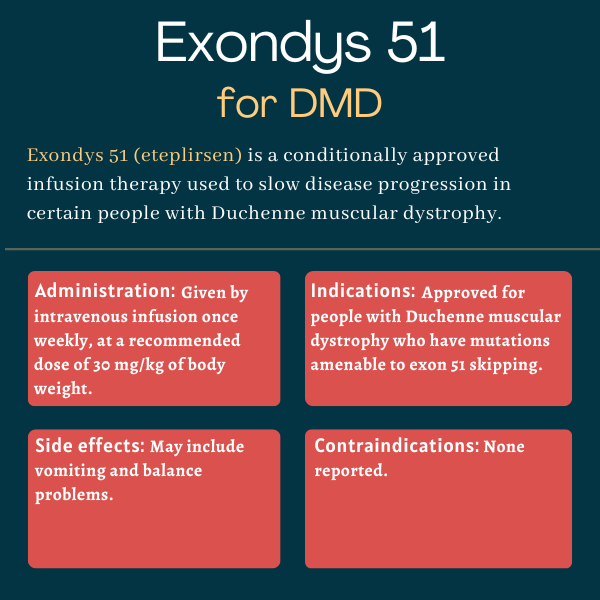Exondys 51 (eteplirsen) for Duchenne muscular dystrophy
Last updated April 19, 2024, by José Lopes, PhD

What is Exondys 51 for Duchenne muscular dystrophy?
Exondys 51 (eteplirsen) is an exon-skipping therapy conditionally approved in the U.S. for people with Duchenne muscular dystrophy (DMD) who have mutations amenable to exon 51 skipping. It is designed to slow disease progression in eligible patients, estimated to comprise about 13% of the total DMD population.
Developed by Sarepta Therapeutics, the therapy is administered as an infusion into the vein, or intravenously.
Its conditional approval was based on early results showing it can significantly raise levels of dystrophin, the protein lacking in Duchenne. Additional clinical trial data showing whether the therapy provides motor function benefits are needed for Exondys 51 to receive full approval.
The therapy was also submitted for regulatory review in Europe, but a committee from the European Medicines Agency adopted a negative opinion in 2018, recommending against its approval in the region.
Therapy snapshot
| Brand name: | Exondys 51 |
| Chemical name: | Eteplirsen |
| Usage: | Used to slow disease progression in DMD patients with mutations amenable to exon 51 skipping |
| Administration: | Intravenous infusion |
How does Exondys 51 work?
DMD is a rare genetic disease caused by mutations in the DMD gene that result in lack of functional dystrophin, a protein that helps to cushion muscle cells from damage during movement. This results in progressive muscle weakness and degeneration, leading to a range of DMD symptoms.
Generally, protein-coding genes contain sections called exons, which contain the information to make the protein, and introns, which are sections of interspacing DNA that don’t code for proteins. When genes are read to produce a protein, an intermediary molecule called messenger RNA is produced, which is processed inside cells to remove introns and glue exons together. However, this process is faulty in DMD.
The DMD gene is the largest in the human genome, containing a total of 79 exons. DMD-causing mutations most commonly result in one or more exons being lost, or deleted, from the DMD messenger RNA molecule. The exons that remain don’t fit together properly, which disrupts production of functional dystrophin.
As an exon-skipping therapy, Exondys 51 works to specifically recognize exon 51 of the DMD gene, directing the cell machinery to exclude this exon from the final messenger RNA molecule. This enables the remaining exons to fit together and ultimately make a shorter, but still functional dystrophin protein. Exondys 51 belongs to a type of small molecule known as antisense oligonucleotides.
Who can use Exondys 51?
Exondys 51 was conditionally approved by the U.S. Food and Drug Administration in 2016 for DMD patients with mutations amenable to exon 51 skipping, marking the first approval of an exon-skipping therapy for the disease.
The approval was made under the accelerated approval pathway, based on early evidence that it could increase levels of dystrophin protein. However, continued approval for this indication will require confirmation of the therapy’s effect on motor function in additional clinical trials.
Who should not use Exondys 51?
The prescribing information for Exondys 51 lists no contraindications. However, patients taking the medication may experience allergic reactions, including chest pain, cough, increased heart rate, and hives, and may need to have their infusion slowed or treatment interrupted.
How is Exondys 51 administered?
Exondys 51 is administered via an intravenous infusion, at a recommended dose of 30 mg per kg of body weight. It’s given once a week by a healthcare provider, and each infusion takes about 35 minutes to an hour.
The medication comes in single-dose vials containing 50 mg of eteplirsen per milliliter of a sterile, clear solution. Two vials are available, one containing 100 mg of eteplirsen in 2 mL of solution and the other containing 500 mg of the medication dissolved in 10 mL of liquid. This will be diluted to the appropriate dosage for each patient by their healthcare provider.
Before being administered Exondys 51, patients may have an anesthetic cream applied to the infusion site. The medication should not be mixed or infused simultaneously with other medications through the same intravenous access line.
In case a dose is missed, the therapy should be administered as soon as possible.

Exondys 51 in clinical trials
Exondys 51 was conditionally approved in the U.S. based on data from three clinical studies: the 201 Phase 2 clinical trial (NCT01396239) and its open-label extension 202 (NCT01540409), and the Phase 3 PROMOVI study (NCT02255552).
Phase 2 trial and open-label extension
The 201 trial enrolled 12 boys with DMD, ages 7 to 13, who were given Exondys 51 at one of two doses (30 or 50 mg/kg), or a placebo, once weekly for 24 weeks, or about six months. All participants then entered the 202 extension study where all were treated with Exondys 51 for up to four years.
The treatment was well tolerated, with no treatment-related adverse events reported, and the 30 mg/kg dose significantly increased the number of dystrophin-positive muscle fibers by 22.9% after 24 weeks, which rose further to 51.7% at 48 weeks.
Also, when two patients with rapid disease progression immediately after enrollment were excluded from the analysis, those who received Exondys 51 experienced improvements in walking ability as measured with the 6-minute walking test, which contrasted with a worsening in the placebo group after 48 weeks.
As placebo data was limited to the initial six months, results from the open-label extension were compared with data from an external control group of boys with DMD. The data showed boys treated with Exondys 51 experienced a significantly slower rate of lung function decline.
After 180 weeks, or nearly three and a half years of treatment, the average dystrophin level was just under 1% of what is seen in people without DMD. Over three years, two of the 12 participants lost the ability to walk, as did six of 13 historical controls in a similar period of time.
PROMOVI Phase 3 trial
To provide additional evidence of Exondys 51’s efficacy in DMD, Sarepta launched the open-label PROMOVI trial, in which DMD patients were treated with 30 mg/kg of Exondys 51 per week for about two years.
The study initially included 109 boys, ages 7 to 16, of whom 79 had mutations amenable to exon 51 skipping and 30 had ineligible mutations. However, the 30 patients were deemed not suitable for a control group because the natural course of DMD varies based on mutation, and they did not receive treatment.
Results showed Exondys 51 increased dystrophin levels by about sevenfold after the two years, with levels reaching 0.63% of normal. Comparisons to historical data also suggested the treatment resulted in clinically meaningful benefits in lung function and in the distance that participants could walk in six minutes, a measure commonly used to assess physical function in patients able to walk.
Combined data from these three trials and another Phase 2 study (NCT02286947) similarly indicated Exondys 51 could significantly slow the decline in lung function compared with glucocorticoids, a standard therapy for DMD. Benefits in lung function were seen regardless of whether participants were able to walk.
Ongoing trial
Sarepta is currently running a two-part Phase 3 study, called MIS51ON (NCT03992430), to further investigate the safety, efficacy, and pharmacological properties of Exondys 51. The first part investigated higher dosages of the medication — 100 and 200 mg/kg — in about 10 patients amenable to exon 51 skipping therapy.
The second part is a double-blind, dose-finding trial that compares those two doses with the previously used 30 mg/kg dose in an estimated 144 patients. The study is ongoing at multiple sites globally.
Side effects of Exondys 51
The most common side effects associated with Exondys 51 in DMD clinical trials were balance problems and vomiting.
Allergic reactions
Some patients treated with Exondys 51 have experienced allergic, or hypersensivity, reactions, including chest pain, cough, bronchospasm (when the muscles that line the airways tighten), increased heart rate, and hives. If such a reaction occurs, patients should receive appropriate medical treatment and their Exondys 51 infusion may need to be slowed or interrupted.
Use in pregnancy and breastfeeding
No human or animal data are available about Exondys 51’s use in pregnancy. It is not known if the therapy can be found in breast milk after being administered, or whether it has any impact on breastfed infants or on milk production. Patients who are pregnant, plan to conceive, are nursing, or plan to breastfeed should discuss these topics with their healthcare providers.
Muscular Dystrophy News Today is strictly a news and information website about the disease. It does not provide medical advice, diagnosis, or treatment. This content is not intended to be a substitute for professional medical advice, diagnosis, or treatment. Always seek the advice of your physician or other qualified health provider with any questions you may have regarding a medical condition. Never disregard professional medical advice or delay in seeking it because of something you have read on this website.
Recent Posts
- DMD treatment Kymbee launches with support program for patients
- Hope takes center stage as musical honors healthcare professionals
- 3-drug cocktail boosts DMD gene therapy effectiveness in mice
- The holiday season makes me regret not making my kids do chores
- Rainy days, Mondays, and FSHD make feeling grateful a challenge
Related articles






